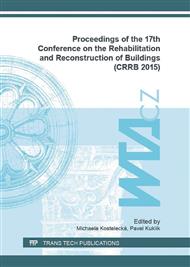p.3
p.10
p.15
p.20
p.25
p.29
p.35
p.40
Bonded Joints in Water-Repellent Timber Structures
Abstract:
Water in liquid and gaseous form is the main factor which significantly affects degradation processes in the wood. The mechanism and rate of wooden degradation processes can be effectively influenced by appropriate methods and technologies for its protection. However new knowledge, based on the possibilities of application of modern physical and chemical analytical methods, confirms that most well-known and previously commonly used protective equipment damages wooden structure. Many chemical substances, which are included in preservatives such as organic and inorganic biocides, or also flame retardants, are declared to be environmentally unacceptable. Nowadays, environmentally friendly treatment technologies of wood have increased attention to the above reasons. Wooden treatment by silicones ranks among the technologies which repellent, fire resistant and corrosion effectiveness is demonstrated by many authors. This article presents results of the experimental study that deals with the mechanical properties of bonded joints in the wood treated by silicones.
Info:
Periodical:
Pages:
3-9
Citation:
Online since:
September 2016
Authors:
Keywords:
Price:
Сopyright:
© 2016 Trans Tech Publications Ltd. All Rights Reserved
Share:
Citation:


